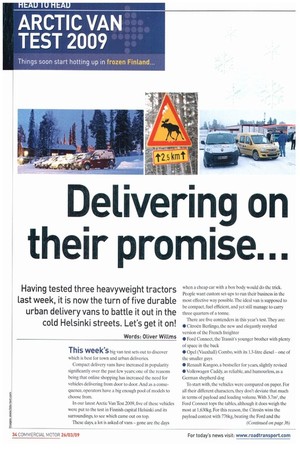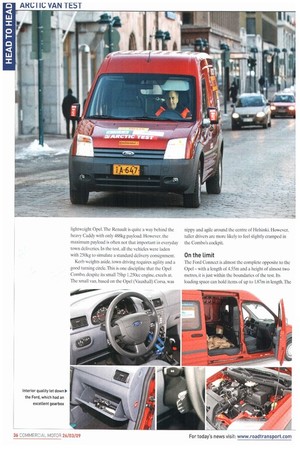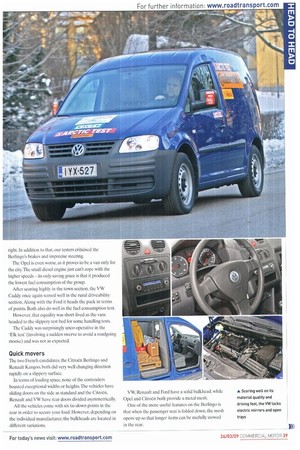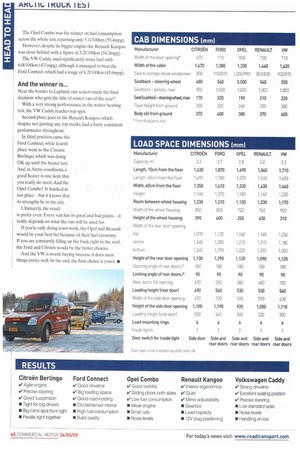elivering on their promise...
Page 34

Page 36

Page 37

Page 38

Page 39

Page 40

If you've noticed an error in this article please click here to report it so we can fix it.
Having tested three heavyweight tractors Last week, it is now the turn of five durable urban delivery vans to battle it out in the cold Helsinki streets. Let's get it on!
Words: Oliver Willms This week's big van test sets out to discover which is best for town and urban deliveries.
Compact delivery vans have increased in popularity significantly over the past few years; one of the reasons being that online shopping has increased the need for vehicles delivering from door to door. And as a consequence, operators have a big enough pool of models to choose from.
In our latest Arctic Van Test 2009, five of these vehicles were put to the test in Finnish capital Helsinki and its surroundings, to see which came out on top.
These days, a lot is asked of vans — gone are the days when a cheap car with a box body would do the trick. People want custom set-ups to run their business in the most effective way possible. The ideal van is supposed to be compact, fuel efficient, and yet still manage to carry three quarters of a tonne.
There are five contenders in this year's test. They are: • Citroen Berlingo, the new and elegantly restyled version of the French freighter • Ford Connect, the Transit's younger brother with plenty of space in the back • Opel (Vauxhall) Combo, with its 1.3-litre diesel — one of the smaller guys • Renault Kangoo, a bestseller for years, slightly revised • Volkswagen Caddy, as reliable, and humourless, as a German shepherd dog To start with, the vehicles were compared on paper. For all their different characters, they don't deviate that much in terms of payload and loading volume. With 3.7m3, the Ford Connect tops the tables, although it does weigh the most at 1,630kg. For this reason, the Citroen wins the payload contest with 776kg, beating the Ford and the lightweight Opel. The Renault is quite a way behind the heavy Caddy with only 488kg payload. However, the maximum payload is often not that important in everyday town deliveries. In the test, all the vehicles were laden with 250kg to simulate a standard delivery consignment.
Kerb weights aside, town driving requires agility and a good turning circle. This is one discipline that the Opel Combo, despite its small 75hp 1,250cc engine, excels at. The small van, based on the Opel (Vauxhall) Corsa, was nippy and agile around the centre of Helsinki. However, taller drivers are more likely to feel slightly cramped in the Combo's cockpit.
On the limit
The Ford Connect is almost the complete opposite to the Opel — with a length of 4.55m and a height of almost two metres, it is just within the boundaries of the test. Its loading space can hold items of up to 1.87m in length. The
Ford has a powerful engine, an excellent gearbox, and is very precise on the road. Unfortunately, its interior is somewhat boring and has some weak points in terms of quality. Ford has announced that the Connect is due to receive a makeover this spring.
The VW Caddy is an excellent example of Teutonic engineering. '[lie northern German van has been around for five years and is certainly not a 'new kid on the block', but it still feels up-to-date. Despite not having a great standard specification, such as the lack of electric mirrors or open trays, the Caddy does bring an air of sophistication — in terms of material quality and driving feel. In addition to this, the vehicle is equipped with the I.9-litre TDI engine, which when coupled to the excellent five-speed gearbox. is a pleasure to drive.
The new Renault Kangoo was not able to impress on our 200km city round trip. Its lacklustre 85hp engine and imprecise gearbox hardly made for great driving around the streets of Helsinki. Its visibility is also not particularly great if you are smaller of stature. However, it does of course have an upside. The 15-litre engine was the most efficient around town with a fuel usage of just 5.81/100km (48.7mpg).
The Ford Connect was undoubtedly the thirstiest of the bunch, with a consumption of 761/100km (372mpg). but it did come joint top of the town points table with the Caddy.
The Citroen followed close behind the Ford and VW while the Renault and the Opel battled it out at the back.The Opel's worst enemies are its small engine and the limited driver space, while the Renault suffers from bad visibility and an uninspiring engine performance.
Cross-country run
The second part of the test took the vehicles on a 900km drive along Finland's motorways and country roads. It also cemented the pros and cons that we'd found during
our town test. Ford and VW once again led the pack with their superior drivelines and driveability. Their size definitely plays to their advantage, not only in load volume, but also in driver space.
The Citroen Berlingo remains in third place due to its good driving dynamics and nippy drive, and the new Berlingo impresses as a good all-rounder — it often feels more like a big estate car rather than a van.
The Renault, unfortunately, can't get rid of its faults on the longer test route — the engine and gearbox are just not right. In addition to that, our testers criticised the Berlingo's brakes and imprecise steering.
The Opel is even worse, as it proves to be a van only for the city. The small diesel engine just can't cope with the higher speeds — its only saving grace is that it produced the lowest fuel consumption of the group.
After scoring highly in the town section. the VW Caddy once again scored well in the rural driveability section. Along with the Ford it heads the pack in terms of points. Both also do well in the fuel consumption test.
However, that equality was short-lived as the vans headed to the slippery test bed for some handling tests.
The Caddy was surprisingly unco-operative in the 'Elk test' (involving a sudden swerve to avoid a roadgoing moose) and was not as expected.
Quick movers The two French candidates, the Citroen Berlingo and Renault Kangoo, both did very well changing direction rapidly on a slippery surface.
In terms of loading space, none of the contenders boasted exceptional widths or heights.The vehicles have sliding doors on the side as standard and the Citroen, Renault and VW have rear doors divided asymmetrically.
All the vehicles come with six tie-down points in the rear in order to secure your load. However, depending on the individual manufacturer, the bulkheads are located in different variations. VW, Renault and Ford have a solid bulkhead. while Opel and Citroen both provide a metal mesh.
One of the more useful features on the Berlingo is that when the passenger seat is folded down, the mesh opens up so that longer items can be usefully stowed in the rear. The Opel Combo was the winner on fuel consumption across the whole test. returning only 5.11/100km (55.4mpg).
However, despite its bigger engine the Renault Kangoo was close behind with a figure of 5.21/100km (54.3mpg).
The VW Caddy used significantly more fuel with 6.01/100km (471mpg), although it managed to beat the Ford Connect, which had a usage of 6.21/100km (45.6mpg).
And the winner is...
Near the border to Lapland, our testers made the final decision: who gets the title of winter van of the year?
With a very strong performance in the winter heating test, the VW Caddy reaches top spot.
Second place goes to the Renault Kangoo, which despite not gaining any top marks, had a fairly consistent performance throughout.
In third position came the Ford Connect, while fourth place went to the Citro01 Berlingo. which was doing OK up until the heater test.
And in Arctic conditions, a good heater is one item that you really do need. And the Opel Combo? It finished in last place but it knows that its strengths lie in the city.
Ultimately, the result is pretty even. Every van has its good and bad points it really depends on what the van will be used for.
If you're only doing town work, the Opel and Renault would be your best bet because of their fuel economy.
If you are constantly filling up the back right to the roof.
the Ford and Citroen would he the better choices.
And the VW is worth buying because it does most things pretty well. In the end, the final choice is yours.












































































































































